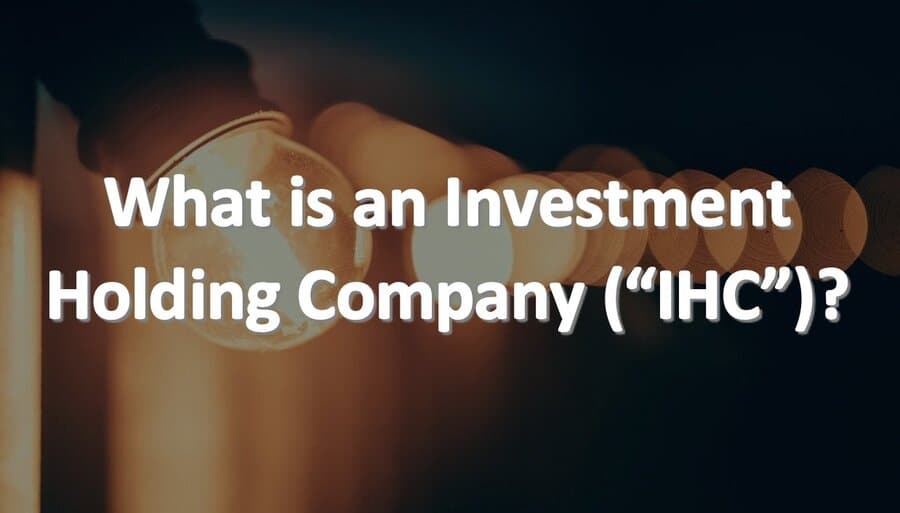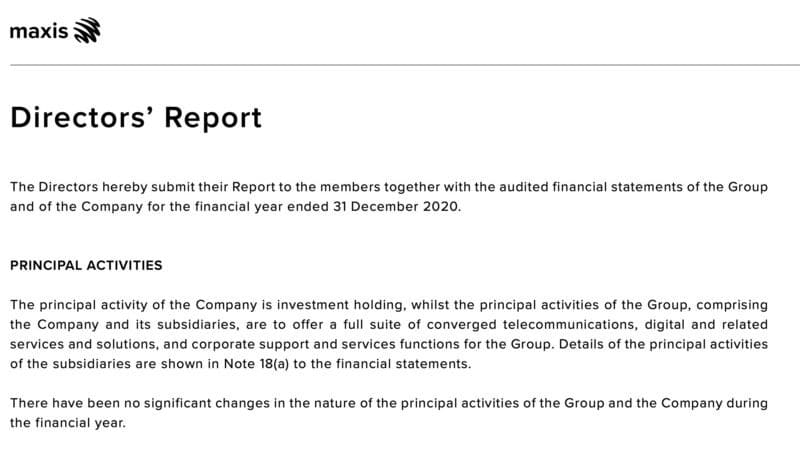Ever noticed that in the annual reports of the stocks you buy, the principal activity of the reporting company is almost always an investment holding company (“IHC”)?

Take Maxis for example, they are one of the main players for telecommunication in Malaysia. In their annual report, it states that the principal activity of the Company is investment holding. But hey Maxis, is a telecommunication company! Why doesn’t it state that instead?

Instead, the report then states that “the principal activities of the Group, comprising the Company and its subsidiaries, are to offer a full suite of converged telecommunications, digital and related services and solutions, and corporate support and services functions for the Group.”, and details of the principal activities of the subsidiaries are shown in a separate note to the financial statements.
So, what exactly is an IHC?
What is an investment holding company (“IHC”)?
| Section 60F(2) to the Income Tax Act 1967 (“ITA”) defines an investment holding company as a company whose activities consist mainly in the holding of investments and not less than 80% of its gross income other than gross income from a source consisting of a business of holding of an investment (whether exempt or not) is derived within. |
Simply put, a company is considered an IHC (whether listed or not) when the company’s main purpose is to:
(1) hold investments; and
(2) they derive at least 80% of their gross income from it.
These gross income are in the form of:
– dividends;
– interest; and
– rental (non-business source).
Why does tax law jargon have to be so bombastic?
(1) What does it mean by business of holding of investments?
According to Sec. 60F(2) and Para 5 of the Public Ruling 10/2015, entitled Investment Holding Company, a business of holding of an investment simply means a business of letting of real property where a company in any year of assessment also comprehensively and actively provides maintenance services or support services in respect of the real property.
| Letting of real property means granting the use of a real property or occupation of a real property under an agreement or a term of contract and includes the letting out of part of the real property that is owned or rented. [Para 5.2 of PR 10/2015] Maintenance services or support services comprehensively provided means services which include:- – doing all things necessary (e.g. cleaning services or repairs) for the maintenance and management of the real property such as structural elements of the building, stairways, fire escapes, entrances and exits, lobbies, corridors, lifts/escalators, compounds, drains, water tanks, sewers, pipes, wires, cables or other fixture and fittings; and – doing generally all things necessary for the maintenance and management of the exterior parts of the real property such as playing fields, recreational areas, driveways, car parks, open spaces, landscape areas, walls and fences, exterior lightning or other external fixture and fittings. [Para 5.3.1 of PR 10/2015] Notes: – The person can provide the above maintenance services or support services comprehensively himself or hire another person or another firm to provide. – If a person only provides security control services or other facilities, that person is not providing maintenance services or support services comprehensively. [Para 5.3.2 of PR 10/2015] |
(2) Derive at least 80% of income from holding of investments
Only gross income from interest and dividend under Sec. 4(c) of the ITA and rental under Sec. 4(d) of the ITA are computed as gross income from the holding of investments. Rental income that are treated as business income under Sec. 4(a) of the ITA is not included in the computation.
| Q: If a company was not IHC in prior year, but subsequently passes the IHC threshold of 80% due to gross income from rental (business of holding of investment) decreases in current year / subsequent years. Is the company now considered IHC? A: The company is still deemed to be a non-IHC if it’s due to temporary cessation of tenancy because of the following circumstances: (a) repair or renovation of the building; (b) absence of tenants for a period of 2 years after termination of tenancy; (c) legal injunction or other official sanction; or (d) circumstances beyond the control of the company. [Para 6.3 of PR No. 10/2015] Likewise, if any company is determined to be an IHC in the basis period for a year of assessment will be deemed to be an IHC in the subsequent years of assessment, until it’s proven otherwise (e.g. change its principal activities from holding of investments to selling hand phones). [Sec. 60F(1B) / 60FA(4) of the ITA; Para 6.4 of PR No. 10/2015] |
2 types of investment holding company
There are two types of investment holding company from a tax point of view in Malaysia – those that are listed on Bursa Malaysia stock exchange, and those who are not. The definition of an investment holding company is the same for both types, though the tax treatment differs for both.
I have taken the liberty to summarise the key differences between the two in the table below.
| IHC (not listed) | Criterion | Listed IHC |
|---|---|---|
| Sec. 60F of the ITA | Governing Law | Sec. 60FA of the ITA. |
| TLDR – No business income. Income from holding of investment Treated as non-business source (i.e. under Sec. 4(c) to 4(d) of the ITA). Income other than income from holding of investment Treated as non-business source income under Sec. 4(f) of the ITA. [Sec. 60F(1A) of the ITA] | Income recognition | Income from holding of investment Treated as business income under Sec. 4(a) of the ITA. [Sec. 60FA(2) of the ITA] |
| Direct expenses: Expenses fulfilling the deductibility tests under Sec. 33(1) of the ITA are deductible from gross income in arriving at adjusted income. Note: Restricted to the amount of gross income from that source for that YA (any excess is disregarded). Examples: – interest expense from loan to finance fixed deposit interest income; – loan interest, quit rent and assessment rates against grouped rental income. Permitted expenses: (a) directors’ fees; (b) wages, salaries and allowances; (c) management fees; (d) secretarial, audit and accounting fees, telephone charges, printing and stationery costs and postage; and (e) rent and other expenses incidental to the maintenance of an office The deduction of permitted expenses will be restricted to a maximum of 5%* of total gross income consisting of interest, dividend and rental for that basis period. | Expense deductibility | Direct expenses: The amount of allowable deduction for direct expenses is restricted to the amount of gross income from that source for YA. (any excess is disregarded) Common expenses: Qualifying common expenses will be prorated between the number of business sources in the ratio of their gross income. (any excess is disregarded) Note: If the particular business source has no income for that YA, no deduction is allowed. |
| Notes: |
| 1. Permitted expenses *The amount of permitted expenses allowed as a deduction determined in accordance with the prescribed formula against the aggregate income in arriving at the total income of an investment holding company for a YA: A x (B/4C), or 5% of B, whichever is lower where: A – the total of the permitted expenses incurred for a basis period reduced by any receipts of a similar kind; B – the gross income consisting of dividend, interest and rent chargeable to tax (i.e. excludes those that are tax exempt) for a basis period; C – aggregate of the gross income consisting of dividend (whether exempt or not), interest and rent, and gains from realisation of investments for a basis period. |
These are the similarities between the two types of IHC:
| Criteria | Description |
|---|---|
| Capital Allowances | Any unabsorbed capital allowances cannot be carried forward and will be disregarded. [Sec. 60FA(3) of the ITA] For 60F, as you have no business income, there is no capital allowance to be utilised against. However, if there is industrial building that qualifies for industrial building allowance, these can be utilised against the gross income from the letting of real property. [Para 60, Sch. 3 of the ITA and Para 11.1 of the PR No. 4/2011 – Income from Letting of Real Property) |
| Losses | If there is no aggregate income or it’s insufficient to absorb the permitted expenses, any excess cannot be carried forward to subsequent years of assessment. [Sec. 60F(1)(b) of the ITA] In other words, any unabsorbed losses will be disregarded. |
Benefits of an investment holding company
Skipping to the less technical (boring) part, why then would someone set up an investment holding company? Are the benefits substantial?
Risk management
Setting up an investment holding company can bring you many benefits in terms of risk management.
i) Separate legal body
Firstly, setting up an IHC means that the company is a legal body representing the investment asset it holds, and exists as a separate legal entity to those individuals involved. This means separate legal liability of debts, loan applications and taxation. Similarly, it can sue and be sued.
ii) Lesser disputes
Secondly, it solves a major headache when it comes to disputes. In an unfortunate event that one of the holder passes away, it’s easier to manage the investment in terms of legal proceedings.
Picture this example, Ali and Abu want to purchase Property A. They can either do it:
a) in their own personal capacity, the property would be under joint names; or
b) use an IHC as an investment vehicle, the property will be under the IHC’s name.
In the unfortunate event that either one passes away, in the first scenario, there will be a legal proceeding to settle the disposal of Property A. However, in the second scenario, the death of either will only affect the shareholding of the investment holding company and not Property A.
There’s also lesser disputes when it comes to decision making – the person that owns the majority of the investment holding company has the final say.
iii) Better safeguards in place
There’s always the fear of embezzlement in any investment venture. When you set up a company, you’ll definitely implement some safeguards such as property authorisation by the banks, thus potentially avoiding such an event from happening.
Easier access to funding
Did you know that you can immediately apply for a loan upon setting up an investment holding company? This is unlike a normal operating company that wants to borrow from a bank, of which they are required to present at least 3 years of audited financial statements. IHC’s have it easier because all of the agreements will state clearly the aspects such as capital invested, shareholding ratios, and who the directors are.
Preferential tax treatments – Reduced tax rates for listed investment holding company (Sec 60FA)
Further to the legislative changes made in the Finance Act 2019, with effect from YA2020, small and medium enterprises (“SMEs”) will be entitled to the following preferential tax treatment if their gross income from a source or sources consisting of a business is not more than RM50 million for the relevant YA:
- Preferential tax rate of 17% for the first RM600,000 of chargeable income of an SME, with the balance taxed at 24%; and
- Unlimited special allowance claim of 100% on assets valued at RM2,000 or less per asset (assuming the asset has been put in use)
Practice Note No. 3/2020 issued by the IRB dated 18 May 2020, titled “Clarification on Determining the Gross Income from Business Sources of not more than RM50 million of a Company or Limited Liability Partnership” provides further guidance to whether IHC’s are entitled to the preferential rate.
| For a company which is an IHC and is: (i) Subject to Section 60F of the ITA (i.e. IHC not listed on Bursa Malaysia), the company is deemed to have no gross business income and is not eligible for the preferential tax treatments (ii) Subject to Section 60FA of the ITA (i.e. IHC listed on Bursa Malaysia), the company is deemed to have gross business income and is eligible for the preferential tax treatments |
Downsides of an Investment Holding Company
Administrative costs
Since you are a company, you’d need to incur annual expenses such as auditor fees and secretarial fees. You’d also need to spend time filing annual company accounts.
Lesser tax savings
As an investment holding company, you don’t get to bring forward any losses for the year, nor are you able to claim any capital allowances should you purchase any assets.
Loan limits
Loan limits for IHC especially for residential properties are much lower than if you’d buy as an individual.
Ultimately, should you set up an Investment Holding Company for property investment?
Though an IHC offers many advantages, you’d need to know that an IHC is just a investment vehicle in property investment. It can get very complex. Hence, it is very important to consult a financial planner, tax accountant and lawyer before you embark on your IHC journey. You’d need to do a proper analysis on the factors to see whether setting up an IHC is indeed beneficial for you.
Questions?
| Disclaimer: The above is solely the author’s point of view. Our content is intended to be used for informational purposes only. It is very important to do your own analysis before making any tax decisions / investment based on your own personal circumstance. You should take independent financial advice from a professional in connection with, or independently research and verify, any information that you find on our website and wish to rely upon, whether for the purpose of making an investment decision or otherwise. |





2 Responses
Can director remuneration and not director fees can deducted as permit ted expenses ?
First, we need to look at the definition of director’s remuneration and director fees. My take is that:
– Director’s remuneration is the salaries and/or bonuses paid to the director every month, and is part of the director’s employment contract signed with the company.
– Director’s fee is the annual fees paid by the employer, including retainer fees and meeting fees as compensation for serving on the board of directors. The fee is usually decided in the general meetings and is approved by the shareholders.
As such, I would treat director’s remuneration if it meets the above definition as part of wages, salaries and allowances, and claim permitted expenses.
Do, however note, that this is solely my point of view.